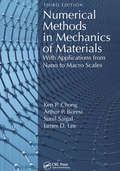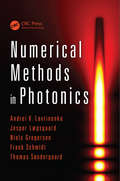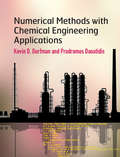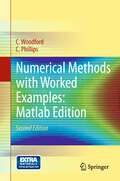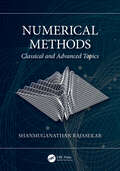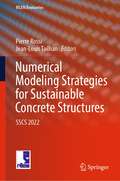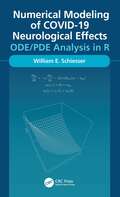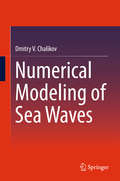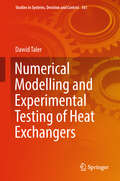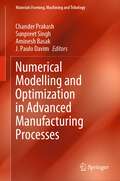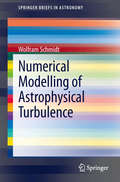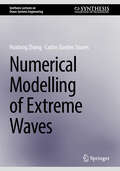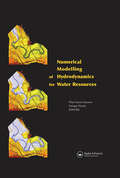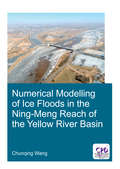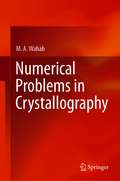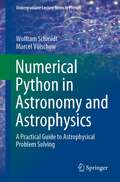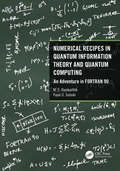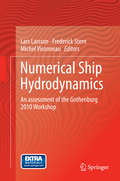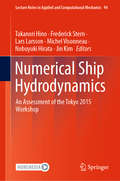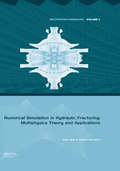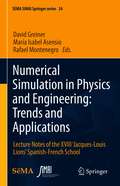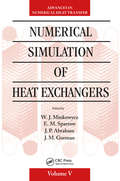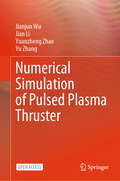- Table View
- List View
Numerical Methods in Mechanics of Materials: With Applications from Nano to Macro Scales
by Arthur P. Boresi Ken P. Chong Sunil Saigal James D. LeeIn the dynamic digital age, the widespread use of computers has transformed engineering and science. A realistic and successful solution of an engineering problem usually begins with an accurate physical model of the problem and a proper understanding of the assumptions employed. With computers and appropriate software we can model and analyze complex physical systems and problems. However, efficient and accurate use of numerical results obtained from computer programs requires considerable background and advanced working knowledge to avoid blunders and the blind acceptance of computer results. This book provides the background and knowledge necessary to avoid these pitfalls, especially the most commonly used numerical methods employed in the solution of physical problems. It offers an in-depth presentation of the numerical methods for scales from nano to macro in nine self-contained chapters with extensive problems and up-to-date references, covering: Trends and new developments in simulation and computation Weighted residuals methods Finite difference methods Finite element methods Finite strip/layer/prism methods Boundary element methods Meshless methods Molecular dynamics Multiphysics problems Multiscale methods
Numerical Methods in Photonics (Optical Sciences and Applications of Light #1)
by Niels Gregersen Andrei V. Lavrinenko Jesper Lægsgaard Frank Schmidt Thomas SøndergaardSimulation and modeling using numerical methods is one of the key instruments in any scientific work. In the field of photonics, a wide range of numerical methods are used for studying both fundamental optics and applications such as design, development, and optimization of photonic components. Modeling is key for developing improved photonic devices and reducing development time and cost. Choosing the appropriate computational method for a photonics modeling problem requires a clear understanding of the pros and cons of the available numerical methods. Numerical Methods in Photonics presents six of the most frequently used methods: FDTD, FDFD, 1+1D nonlinear propagation, modal method, Green’s function, and FEM. After an introductory chapter outlining the basics of Maxwell’s equations, the book includes self-contained chapters that focus on each of the methods. Each method is accompanied by a review of the mathematical principles in which it is based, along with sample scripts, illustrative examples of characteristic problem solving, and exercises. MATLAB® is used throughout the text. This book provides a solid basis to practice writing your own codes. The theoretical formulation is complemented by sets of exercises, which allow you to grasp the essence of the modeling tools.
Numerical Methods with Chemical Engineering Applications
by Prodromos Daoutidis Kevin D. DorfmanDesigned primarily for undergraduates, but also graduates and practitioners, this textbook integrates numerical methods and programming with applications from chemical engineering. Combining mathematical rigor with an informal writing style, it thoroughly introduces the theory underlying numerical methods, its translation into MATLAB programs, and its use for solving realistic problems. Specific topics covered include accuracy, convergence and numerical stability, as well as stiffness and ill-conditioning. MATLAB codes are developed from scratch, and their implementation is explained in detail, all while assuming limited programming knowledge. All scripts employed are downloadable, and built-in MATLAB functions are discussed and contextualised. Numerous examples and homework problems - from simple questions to extended case studies - accompany the text, allowing students to develop a deep appreciation for the range of real chemical engineering problems that can be solved using numerical methods. This is the ideal resource for a single-semester course on numerical methods, as well as other chemical engineering courses taught over multiple semesters.
Numerical Methods with Worked Examples: Matlab Edition
by C. Phillips C. WoodfordThis book is for students following an introductory course in numerical methods, numerical techniques or numerical analysis. It introduces MATLAB as a computing environment for experimenting with numerical methods. It approaches the subject from a pragmatic viewpoint; theory is kept at a minimum commensurate with comprehensive coverage of the subject and it contains abundant worked examples which provide easy understanding through a clear and concise theoretical treatment. This edition places even greater emphasis on 'learning by doing' than the previous edition. Fully documented MATLAB code for the numerical methods described in the book will be available as supplementary material to the book on http://extras.springer.com
Numerical Methods: Classical and Advanced Topics
by Shanmuganathan RajasekarThis book presents a pedagogical treatment of a wide range of numerical methods to suit the needs of undergraduate and postgraduate students, and teachers and researchers in physics, mathematics, and engineering. For each method, the derivation of the formula/algorithm, error analysis, case studies, applications in science and engineering and the special features are covered. A detailed presentation of solving time-dependent Schrödinger equation and nonlinear wave equations, along with the Monte Carlo techniques (to mention a few) will aid in students’ understanding of several physical phenomena including tunnelling, elastic collision of nonlinear waves, electronic distribution in atoms, and diffusion of neutrons through simulation study.The book covers advanced topics such as symplectic integrators and random number generators for desired distributions and Monte Carlo techniques, which are usually overlooked in other numerical methods textbooks. Interesting updates on classical topics include: curve fitting to a sigmoid and Gaussian functions and product of certain two functions, solving of differential equations in the presence of noise, and solving the time-independent Schrödinger equation.Solutions are presented in the forms of tables and graphs to provide visual aid and encourage a deeper comprehension of the topic. The step-by-step computations presented for most of the problems can be verifiable using a scientific calculator and is therefore appropriate for classroom teaching. The readers of the book will benefit from acquiring an acquittance, knowledge, experience and realization of significance of the numerical methods covered, their applicability to physical and engineering problems and the advantages of applying numerical methods over theoretical methods for specific problems.
Numerical Modeling Strategies for Sustainable Concrete Structures: SSCS 2022 (RILEM Bookseries #38)
by Pierre Rossi Jean-Louis TailhanThis volume highlights the latest advances, innovations, and applications in the field of sustainable concrete structures, as presented by scientists and engineers at the RILEM International Conference on Numerical Modeling Strategies for Sustainable Concrete Structures (SSCS), held in Marseille, France, on July 4-6, 2022. It demonstrates that numerical methods (finite elements, finite volumes, finite differences) are a relevant response to the challenge to optimize the utilization of cement in concrete constructions while checking that these constructions have a lifespan compatible with the stakes of sustainable development. They are indeed accurate tools for an optimized design of concrete constructions, and allow us to consider all types of complexities: for example, those linked to rheological, physicochemical and mechanical properties of concrete, those linked to the geometry of the structures or even to the environmental boundary conditions. This optimization must also respect constraints of time, money, security, energy, CO2 emissions, and, more generally, life cycle more reliably than the codes and analytical approaches currently used. Numerical methods are, undoubtedly, the best calculation tools at the service of concrete eco-construction. The contributions present traditional and new ideas that will open novel research directions and foster multidisciplinary collaboration between different specialists.
Numerical Modeling of COVID-19 Neurological Effects: ODE/PDE Analysis in R
by William SchiesserCovid-19 is primarily a respiratory disease which results in impaired oxygenation of blood. The O2-deficient blood then moves through the body, and for the study in this book, the focus is on the blood flowing to the brain. The dynamics of blood flow along the brain capillaries and tissue is modeled as systems of ordinary and partial differential equations (ODE/PDEs). The ODE/PDE methodology is presented through a series of examples, 1. A basic one PDE model for O2 concentration in the brain capillary blood. 2. A two PDE model for O2 concentration in the brain capillary blood and in the brain tissue, with O2 transport across the blood brain barrier (BBB). 3. The two model extended to three PDEs to include the brain functional neuron cell density. Cognitive impairment could result from reduced neuron cell density in time and space (in the brain) that follows from lowered O2 concentration (hypoxia). The computer-based implementation of the example models is presented through routines coded (programmed) in R, a quality, open-source scientific computing system that is readily available from the Internet. Formal mathematics is minimized, e.g., no theorems and proofs. Rather, the presentation is through detailed examples that the reader/researcher/analyst can execute on modest computers. The PDE analysis is based on the method of lines (MOL), an established general algorithm for PDEs, implemented with finite differences. The routines are available from a download link so that the example models can be executed without having to first study numerical methods and computer coding. The routines can then be applied to variations and extensions of the blood/brain hypoxia models, such as changes in the ODE/PDE parameters (constants) and form of the model equations.
Numerical Modeling of Sea Waves
by Dmitry V. ChalikovPresenting a novel approach to wave theory, this book applies mathematical modeling to the investigation of sea waves. It presents problems, solutions and methods, and explores issues such as statistical properties of sea waves, generation of turbulence, Benjamin-Feir instability and the development of wave fields under the action of wind. Special attention is paid to the processes of dynamic wind-wave interaction, the formation of freak waves, as well as the role that sea waves play in the dynamic ocean/atmosphere system. It presents theoretical results which are followed by a description of the algorithms used in the development of wave forecasting models, and provides illustrations to assist understanding of the various models presented. This book provides an invaluable resource to oceanographers, specialists in fluid dynamics and advanced students interested in investigation of the widely known but poorly investigated phenomenon of sea waves.
Numerical Modelling and Experimental Testing of Heat Exchangers (Studies in Systems, Decision and Control #161)
by Dawid TalerThis book presents new methods of numerical modelling of tube heat exchangers, which can be used to perform design and operation calculations of exchangers characterized by a complex flow system. It also proposes new heat transfer correlations for laminar, transition and turbulent flows. A large part of the book is devoted to experimental testing of heat exchangers, and methods for assessing the indirect measurement uncertainty are presented. Further, it describes a new method for parallel determination of the Nusselt number correlations on both sides of the tube walls based on the nonlinear least squares method and presents the application of computational fluid dynamic (CFD) modeling to determine the air-side Nusselt number correlations. Lastly, it develops a control system based on the mathematical model of the car radiator and compares this with the digital proportional-integral-derivative (PID) controller. The book is intended for students, academics and researchers, as well as for designers and manufacturers of heat exchangers.
Numerical Modelling and Optimization in Advanced Manufacturing Processes (Materials Forming, Machining and Tribology)
by J. Paulo Davim Chander Prakash Sunpreet Singh Aminesh BasakThis book presents different numerical modeling and nature-inspired optimization methods in advanced manufacturing processes for understanding the process characteristics. Particular emphasis is devoted to applications in non-conventional machining, nano-finishing, precision casting, porous biofabrication, three-dimensional printing, and micro-/nanoscale modeling. The book includes practical implications of empirical, analytical, and numerical models for predicting the vital output responses. Especial attention is given to finite element methods (FEMs) for understanding the design of novel highly complex engineering products, their performances, and behaviors under simulated processing conditions.
Numerical Modelling of Astrophysical Turbulence
by Wolfram SchmidtIn this "SpringerBrief" the author considers the underlying problems and questions that are common to numerical models of turbulence in different astrophysical systems. Turbulence has emerged as an important research topic in several areas of astrophysics. Understanding and modeling turbulence is particularly important for the dynamics of the interstellar medium, but also for the intergalactic medium, as well as in stars. The advancement of methods for numerical simulations of astrophysical turbulence, however, is still challenging because of gravity, strong compressibility, magnetic fields, and other effects. The book begins with a review of general aspects of numerical simulations of turbulence. In the main part the author presents findings from his numerical studies on astrophysical turbulence and discusses the astrophysical implications. He also explains in detail the numerical schemes utilized. Readers will find that this book offers a compact yet comprehensive introduction.
Numerical Modelling of Extreme Waves (Synthesis Lectures on Ocean Systems Engineering)
by Huidong Zhang Carlos Guedes SoaresThis book describes some approaches for developing the numerical models to efficiently predict the formation of extreme waves which can pose a threat to the safety of marine structures. The numerical algorithms for solving different governing equations and the theoretical probability models for extreme wave predictions are explained in detail. These models can help engineers in the design of marine structures that can withstand extreme waves. With more frequent extreme weather due to climate change, extreme waves have become more common. Extreme waves are an interesting phenomenon, but because of their enormous destructive power, understanding their formation mechanism, properties, and impact, is necessary for the design and safe operation of ships and offshore structures.
Numerical Modelling of Hydrodynamics for Water Resources: Proceedings of the Conference on Numerical Modelling of Hydrodynamic Systems (Zaragoza, Spain, 18-21 June 2007)
by Pilar García-Navarro Enrique PlayánThe presentations collected in this volume have a problem-oriented perspective, and focus on canal and river flow, riparian areas and aquifers. 'Numerical Modelling of Hydrodynamics for Water Resources' is highly relevant to those working in hydrology, civil engineering, and environmental and agricultural sectors.
Numerical Modelling of Ice Floods in the Ning-Meng Reach of the Yellow River Basin (IHE Delft PhD Thesis Series)
by Chunqing WangThe Ning-Meng reach of the Yellow River basin is located in the Inner Mongolia region at the Northern part of the Yellow River. Due to the special geographical conditions, the river flow direction is towards the North causing the Ning-Meng reach to freeze up every year in wintertime. Both during the freeze-up and break-up period, unfavourable conditions occur which may cause ice jamming and ice dam formation leading to dike breaching and overtopping of the embankment. Throughout history this has often led to considerable casualties and property loss. Enhanced economic development and human activities in the region have altered the characteristics of the ice regime in recent decades, leading to several ice disasters during freezing or breaking-up periods. The integrated water resources management plan developed by the Yellow River Conservancy Commission (YRCC) outlines the requirements for water regulation in the upper Yellow River during ice flood periods. YRCC is developing measures that not only safeguard against ice floods, but also assure the availability of adequate water resources. These provide the overall requirements for developing an ice regime forecasting system including lead-time prediction and required accuracy. In order to develop such a system, numerical modelling of ice floods is an essential component of current research at the YRCC, together with field observations and laboratory experiments. In order to properly model river ice processes it is necessary to adjust the hydrodynamic equations to account for thermodynamic effects. In this research, hydrological and meteorological data from 1950 to 2010 were used to analyse the characteristics of ice regimes in the past. Also, additional field observations were carried out for ice flood model calibration and validation. By combining meteorological forecasting models with statistical models, a medium to short range air temperature forecasting model for the Ning-Meng reach was established. These results were used to improve ice formation modelling and prolong lead-time prediction. The numerical ice flood model developed in this thesis for the Ning-Meng reach allows better forecasting of the ice regime and improved decision support for upstream reservoir regulation and taking appropriate measures for disaster risk reduction.
Numerical Problems in Crystallography
by M. A. WahabThis book aims at enhancing the understanding of topics in crystallography through solving numerical problems. Designed into nine chapters on major topics in crystallography, the book deals with more than 600 carefully selected solved examples, problems, and multiple-choice questions. Unit cell composition, construction and calculations, Miller indices, structure factor calculations, and X-ray diffraction methods are some of the many useful topics discussed in this book. Each chapter begins with a brief theoretical explanation of the topic followed by solved numerical examples for further clarity on the subject. The topic “crystallography” is interdisciplinary in nature. Its rudimentary knowledge, therefore, is essential to the beginners in physics, chemistry, mathematics, molecular biology, geology, metallurgy, and particularly materials science and mineralogy. This book also is of immense value to senior undergraduate and graduate students of physics, chemistry, and other basic sciences.
Numerical Python in Astronomy and Astrophysics: A Practical Guide to Astrophysical Problem Solving (Undergraduate Lecture Notes in Physics)
by Wolfram Schmidt Marcel VölschowThis book provides a solid foundation in the Python programming language, numerical methods, and data analysis, all embedded within the context of astronomy and astrophysics. It not only enables students to learn programming with the aid of examples from these fields but also provides ample motivation for engagement in independent research. The book opens by outlining the importance of computational methods and programming algorithms in contemporary astronomical and astrophysical research, showing why programming in Python is a good choice for beginners. The performance of basic calculations with Python is then explained with reference to, for example, Kepler’s laws of planetary motion and gravitational and tidal forces. Here, essential background knowledge is provided as necessary. Subsequent chapters are designed to teach the reader to define and use important functions in Python and to utilize numerical methods to solve differential equations and landmark dynamical problems in astrophysics. Finally, the analysis of astronomical data is discussed, with various hands-on examples as well as guidance on astronomical image analysis and applications of artificial neural networks.
Numerical Recipes in Quantum Information Theory and Quantum Computing: An Adventure in FORTRAN 90
by M.S. Ramkarthik Payal D. SolankiThis first of a kind textbook provides computational tools in Fortran 90 that are fundamental to quantum information, quantum computing, linear algebra and one dimensional spin half condensed matter systems. Over 160 subroutines are included, and the numerical recipes are aided by detailed flowcharts. Suitable for beginner and advanced readers alike, students and researchers will find this textbook to be a helpful guide and a compendium. Key Features: Includes 160 subroutines all of which can be used either as a standalone program or integrated with any other main program without any issues. Every parameter in the input, output and execution has been provided while keeping both beginner and advanced users in mind. The output of every program is explained thoroughly with detailed examples. A detailed dependency chart is provided for every recipe.
Numerical Relativity: Solving Einstein's Equations on the Computer
by Thomas W. Baumgarte Stuart L. ShapiroAimed at students and researchers entering the field, this pedagogical introduction to numerical relativity will also interest scientists seeking a broad survey of its challenges and achievements. Assuming only a basic knowledge of classical general relativity, the book develops the mathematical formalism from first principles, and then highlights some of the pioneering simulations involving black holes and neutron stars, gravitational collapse and gravitational waves. The book contains 300 exercises to help readers master new material as it is presented. Numerous illustrations, many in color, assist in visualizing new geometric concepts and highlighting the results of computer simulations. Summary boxes encapsulate some of the most important results for quick reference. Applications covered include calculations of coalescing binary black holes and binary neutron stars, rotating stars, colliding star clusters, gravitational and magnetorotational collapse, critical phenomena, the generation of gravitational waves, and other topics of current physical and astrophysical significance.
Numerical Relativity: Starting from Scratch
by Thomas W. Baumgarte Stuart L. ShapiroNumerical relativity has emerged as the key tool to model gravitational waves - recently detected for the first time - that are emitted when black holes or neutron stars collide. This book provides a pedagogical, accessible, and concise introduction to the subject. Relying heavily on analogies with Newtonian gravity, scalar fields and electromagnetic fields, it introduces key concepts of numerical relativity in a context familiar to readers without prior expertise in general relativity. Readers can explore these concepts by working through numerous exercises, and can see them 'in action' by experimenting with the accompanying Python sample codes, and so develop familiarity with many techniques commonly employed by publicly available numerical relativity codes. This is an attractive, student-friendly resource for short courses on numerical relativity, as well as providing supplementary reading for courses on general relativity and computational physics.
Numerical Ship Hydrodynamics
by Lars Larsson Frederick Stern Michel VisonneauThis book assesses the state-of-the-art in computational fluid dynamics (CFD) applied to ship hydrodynamics and provides guidelines for the future developments in the field based on the Gothenburg 2010 Workshop. It presents ship hull test cases, experimental data and submitted computational methods, conditions, grids and results. Analysis is made of errors for global (resistance, sinkage and trim and self-propulsion) and local flow (wave elevations and mean velocities and turbulence) variables, including standard deviations for global variables and propeller modeling for self-propulsion. The effects of grid size and turbulence models are evaluated for both global and local flow variables. Detailed analysis is made of turbulence modeling capabilities for capturing local flow physics. Errors are also analyzed for head-wave seakeeping and forward speed diffraction, and calm-water forward speed-roll decay. Resistance submissions are used to evaluate the error and uncertainty by means of a systematic verification and validation (V&V) study along with statistical investigations. Post-workshop experimental and computational studies are conducted and analyzed for evaluation of facility biases and to draw more concrete conclusions regarding the most reliable turbulence model, appropriate numerical methods and grid resolution requirements, respectively.
Numerical Ship Hydrodynamics: An Assessment of the Tokyo 2015 Workshop (Lecture Notes in Applied and Computational Mechanics #94)
by Lars Larsson Frederick Stern Michel Visonneau Takanori Hino Nobuyuki Hirata Jin KimThis book explores computational fluid dynamics applied to ship hydrodynamics and provides guidelines for the future developments in the field based on the Tokyo 2015 Workshop. It presents ship hull test cases, experimental data and submitted computational methods, conditions, grids and results. Analysis is made of errors for global (resistance, sinkage, trim and self-propulsion) and local flow (wave elevations, mean velocities and turbulence) variables, including standard deviations for global variables. The effects of grid size and turbulence models are evaluated for both global and local flow variables. Detailed analysis is made of turbulence modeling capabilities for capturing local flow physics. Errors and standard deviations are also assessed for added resistance (captive test cases) and course keeping/speed loss (free running test cases) in head and oblique waves. All submissions are used to evaluate the error and uncertainty by means of a systematic verification and validation (V&V) study along with statistical investigations.
Numerical Simulation in Hydraulic Fracturing: Multiphysics Theory and Applications (Multiphysics Modeling #1)
by Xinpu Shen William StandifirdThe expansion of unconventional petroleum resources in the recent decade and the rapid development of computational technology have provided the opportunity to develop and apply 3D numerical modeling technology to simulate the hydraulic fracturing of shale and tight sand formations. This book presents 3D numerical modeling technologies for hydraulic fracturing developed in recent years, and introduces solutions to various 3D geomechanical problems related to hydraulic fracturing. In the solution processes of the case studies included in the book, fully coupled multi-physics modeling has been adopted, along with innovative computational techniques, such as submodeling. In practice, hydraulic fracturing is an essential project component in shale gas/oil development and tight sand oil, and provides an essential measure in the process of drilling cuttings reinjection (CRI). It is also an essential measure for widened mud weight window (MWW) when drilling through naturally fractured formations; the process of hydraulic plugging is a typical application of hydraulic fracturing. 3D modeling and numerical analysis of hydraulic fracturing is essential for the successful development of tight oil/gas formations: it provides accurate solutions for optimized stage intervals in a multistage fracking job. It also provides optimized well-spacing for the design of zipper-frac wells.Numerical estimation of casing integrity under stimulation injection in the hydraulic fracturing process is one of major concerns in the successful development of unconventional resources. This topic is also investigated numerically in this book. Numerical solutions to several other typical geomechanics problems related to hydraulic fracturing, such as fluid migration caused by fault reactivation and seismic activities, are also presented. This book can be used as a reference textbook to petroleum, geotechnical and geothermal engineers, to senior undergraduate, graduate and postgraduate students, and to geologists, hydrogeologists, geophysicists and applied mathematicians working in this field. This book is also a synthetic compendium of both the fundamentals and some of the most advanced aspects of hydraulic fracturing technology.
Numerical Simulation in Physics and Engineering: Lecture Notes of the XVIII ‘Jacques-Louis Lions’ Spanish-French School (SEMA SIMAI Springer Series #24)
by David Greiner María Isabel Asensio Rafael MontenegroThis book results from the XVIII Spanish-French School 'Jacques Louis Lions' on Numerical Simulation in Physics and Engineering, that took place in Las Palmas de Gran Canaria from 25th to 29th June 2018. These conferences are held biennially since 1984 and sponsored by the Spanish Society of Applied Mathematics (SEMA). They also have the sponsorship of the Société de Mathématiques Appliquées et Industrielles (SMAI) of France since 2008. Each edition is organized around several main courses and talks delivered by renowned French/Spanish scientists. This volume is highly recommended to graduate students in Engineering or Science who want to focus on numerical simulation, either as a research topic or in the field of industrial applications. It can also benefit senior researchers and technicians working in industry who are interested in the use of state-of-the-art numerical techniques. Moreover, the book can be used as a textbook for master courses in Mathematics, Physics, or Engineering.
Numerical Simulation of Heat Exchangers: Advances in Numerical Heat Transfer Volume V (Computational and Physical Processes in Mechanics and Thermal Sciences)
by W. J. Minkowycz; E. M. Sparrow; J. P. Abraham; J. M. GormanThis book deals with certain aspects of material science, particularly with the release of thermal energy associated with bond breaking. It clearly establishes the connection between heat transfer rates and product quality. The editors then sharply draw the thermal distinctions between the various categories of welding processes, and demonstrate how these distinctions are translated into simulation model uniqueness. The book discusses the incorporation of radiative heat transfer processes into the simulation model.
Numerical Simulation of Pulsed Plasma Thruster
by Jian Li Yu Zhang Jianjun Wu Yuanzheng ZhaoThis is an open access book. It is valuable in gaining an understanding of the working mechanism of pulsed plasma thrusters. It facilitates the evaluation of the thruster's working characteristics and propulsive performance, thereby providing a crucial theoretical foundation and reference for the design, development, and engineering application of pulsed plasma thrusters. Additionally, this book significantly contributes to the advancement of space electric propulsion technology. Researchers and engineers in the aerospace propulsion field can greatly benefit from the insights presented within this book.
